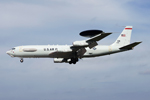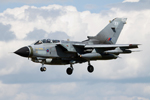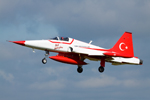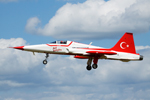Arguably, the stars of the static line-up were the two AMI F-16As from Trapani’s 18° Gruppo / 37° Stormo which, by the time of show, happened to be the home of all AMI Vipers before they go back to the United States. Given that, effectively, their next stop would be Arizona, even ‘standard’ AMI Vipers would have been extremely well received but this pair featured rather more colour than a common or garden variety – one simply had fancy tail artwork whilst the other was a work of art in a well-done black and lime green scheme. Very impressive. However, their parking left quite a lot to be desired; parked up on the taxiway, photography wasn’t the easiest. |
|
|
The attendance of a 38th RS RC-135W all the way from Offutt AFB, Nebraska was also a pleasant inclusion and clearly a nod to the fact that once the extremely competent 51 Squadron Nimrod R.1s are retired, their ELINT role will be taken over by three of our own [apparently] slightly less competent Rivet Joints. It wasn’t as if the thing had made a short hop from Suffolk either – it came the 4,000+ miles from Nebraska solely for the show. The more eagle eyed punter might have also noticed that at least one of the RC-135s crew was sporting a 51 Squadron patch on his arm. The aircraft was, however, stuffed away in a corner of Alpha dispersal so could have been parked a little better although with a sneaky-beaky platform like the Rivet Joint, the parking spot probably aided security. |
Also parked up on Alpha and coming just as far was a 964th AACS E-3B Sentry from Tinker AFB, Oklahoma. Makes you wonder though… Waddington is home of the RAF’s Sentry force, has trained many personnel on the said platform and yet the only foreign E-3 that turns up for a show celebrating 35 years of E-3 operations and 20 years of RAF E-3 operations is from the US. Both NATO and French E-3s were supposed to have been participating and examples of neither type made it into Lincolnshire. Quite what Waddington need to do to get that specially painted NATO E-3A into the airshow, goodness only knows. If the Sentry anniversary show can’t tempt it over, we’re probably doomed to never see it at a show here. |
|
Other US residents of Alpha came courtesy of USAFE and consisted of a pair of 23rd FS Stingers F-16CJs from Spangdahlem (which will be their last time at Waddington before disbanding and subsequently forming part of the 480th FS Warhawks later this summer), an 37th AS C-130J from Ramstein and a 351st ARS ARW KC-135R Stratotanker from just down the road at RAF Mildenhall. These were joined by a 51 Squadron Nimrod R.1, an 8/23/54 Squadron Sentry AEW.1, a 673 Squadron WAH-64D Apache, an 857NAS Sea King ASaC.7 and a 33/230 Squadron Puma HC.1. I’m quite surprised the Sentry was dragged out at all considering the lack of engines and the windows and panels being taped up as poorly-sick looking aircraft are typically something hidden away in a hangar somewhere, never mind wheeled out for show. The same could be said of the Nimrod R.1 given it isn’t exactly an active jet any more. |
Tornados weren’t exactly in short supply this year either – no less than four were to be found in amongst the static park, including a 111 Squadron Tremblers Tornado F.3 which has sadly now seen its last Waddington show as the squadron will have gone by the time the 2011 show comes round. An AG51 Immelmann Tornado IDS from Schleswig-Jagel was the sole foreign operated Tonka whilst the other two were a fully marked 617 Squadron Dambusters Tornado GR.4 [albeit with a 12 Squadron crew] from Lossiemouth and a 41(R) Squadron Tornado GR.4 from Coningsby. Also hailing from Coningsby was another 41(R) Squadron stable mate in the shape of a Harrier GR.9, complete with pairs of drill AGM-65 Mavericks and ASRAAMs under the wings, and a 6 Squadron Canopeners Typhoon FGR.4 devoid of any squadron markings. |
The only other RAF fast jet in the static was a lone 208(R) Squadron Hawk T.1, although QinetiQ had sent up their rather smart black Alpha Jet for a weekend in Lincolnshire. A number of foreign participants were also parked up on Foxtrot dispersal: an Austrian LuTSta C-130K Hercules from Linz and a chunk of the sizeable Czech AF contingent consisting of a 242.tsl An-26 Curl from Praha-Kbely and a Čáslav-based 211.tl JAS-39D Gripen. A Polish Navy 30.elMW M-28B Bryza-1R from Cewice and, looking extensively used and abused, an AdA C-160R Transall of ET 01.064 at Evreux. Also knocking about down on Foxtrot was another Sentry, a 5(AC) Squadron Sentinel R.1 (with, in a neat touch, its ground support gadgetry) plus a 60(R) Squadron Griffin HT.1 and DHFS Squirrel HT.1. |
A ‘goodie’ came in the form of a 651 Squadron AAC Defender T.3 painted in what can only be described as “civilian camouflage”. Park this particular beastie up amongst a load of Cessnas and Pipers somewhere and you’d have to be damn near on top of it before you realised it said ARMY down the flanks. It doesn’t take Einstein to have an educated guess at what 651 Squadron do for a living so it’s probably best left at that. An area between hangar 3 and 4 was set aside for the UAS display and meant a number of UAVs, sorry, UASs were out on display – or, more specifically, in the case of the RQ-4 Global Hawk, X-UAS and Mantis, models were. The Army’s new Hermes 450-based Watchkeeper was also on display and if it wasn’t real, it was a pretty convincing model. UAS, by the way, means Unmanned Aircraft Systems, and is basically a new term for UAV although it also encompasses the ground support equipment in addition to the actual aircraft. |
In what is almost a yearly complaint from many, there was just far too many Austers and general aviation aircraft; without counting, there was probably twenty plus of the things. I don’t think I’ll repeat what was overheard on the topic of these particular aircraft just in case it causes offence to their owners but it is clearly not just my opinion that there are too many at what is supposed to be the RAF’s premier airshow. If it was the Lincoln Flying Club’s premier airshow, I could grasp the concept, but it’s not so do we really need to have space taken up by untold numbers of these things – personally, I’d like to see Waddington drop the numbers of these types of participants and give the rest of the static aircraft more space. Quality over quantity springs to mind. |
Whilst clearly the static is just one part of the show, where things picked up immeasurably was with the flying display. Opening up the seven hour programme was the home ISTAR team trio of the Nimrod R.1, Sentinel R.1 and Sentry AEW.1 although always good to see the home units strut their stuff, it was sadly lacking the three-ship flypasts and break that has been done before. Interestingly, whilst the Sentinel and Sentry came home, the Nimrod did a vanishing act and went elsewhere for about 4½ hours. Obviously existing commitments come into play but seeing the newest of the ISTAR team, the Shadow R.1, alongside its much better known stable mates would have been more than welcome. With the ISTAR elements out of the way, the next act basically kicked off the 90th anniversary of the first RAF pageant with a flypast of vintage aircraft which led into the Great War Display Team’s display which featured aircraft such as the SE.5a, Sopwith Triplane, Sopwith Pup, Nieuport 17, Fokker Triplane and Junker CL1. |
After the RAF Falcons Parachute Display Team had decided to leave a perfectly serviceable Chinook at a few thousand feet, Team Viper with their Strikemasters and Hunters brought the show into the jet age. I have to say, they’re not bad and the Hunter fast pass with the characteristic blue note is superb. Other classic jets making an appearance during the day included the RNHF’s smart Sea Hawk FGA.6 and, of course, Vulcan XH558 which still seems to be as popular as it’s ever been. It almost didn’t even make it to Waddington, which didn’t exactly come as a surprise, as vital paperwork was very nearly lacking and the display should have had pyrotechnics but that never transpired for one reason or another. Sadly, coming in as it did direct from Brize Norton, we weren’t treated to the fantastic howl of the four Bristol Olympus engines giving it some what-for – neither did we get to see it land as it headed off back to Brize after an expectedly tame routine. There aren’t many places where you can see a pair of Vulcans together though! |
Fast jets, and slightly slower ones for that matter, were well represented on the billing and even brought ever-popular aircraft back into the public eye – those being the Tornado and Harrier role demos. The Tonka role demo is basically two XV(R) Squadron jets simulating a CAS mission (sadly, this is something Tonka crews have to do for real out in Afghanistan) with shows of force, cannon strafing runs, Brimstone attacks and industrial scale regeneration with 1,000lb retarded bombs. Think of the RAF Role Demonstration from a handful of years ago, get rid of most of the aircraft and tone it down a smidgen. Not only is it something different, it’s quite enjoyable. Hats off to XV(R) Squadron… nice one guys. The Harrier ‘role demo’ however, is little more than showing off the VSTOL abilities and standard Harrier party tricks. No bad thing, I think you’ll agree, as the Harrier has been sadly off the recent display circuit thanks to a seriously heavy workload to deal with yet it’s good to see it back. Here’s to hoping it sticks around, perhaps with a few tweaks to introduce a bit more actual ‘flying’, for as long as the Harrier does… however long that will be. |
|
The Czech AF, who have always been supporters of Waddington, had chipped in with their Gripen and L-159 demos. I have to be honest, I wasn’t expecting much from the L-159T1 ALCA but this little jet actually puts on a decent, spirited display. It’s not quite up to the level of the RAF Hawk but I was pleasantly surprised by it. The JAS-39C Gripen, however, was as expected for a modern agile fast jet and as good a demo as I’ve seen from the Swedish export. Like the JAS-39D in the static, the display jet hailed from Čáslav’s 211.tl. Whilst on the subject of modern agile fast jets, the Belgians joined the party with the 2010 F-16 Solo Display Team. The team’s two jets, including the rather tidy “Vortex” display jet, arrived in impressive style on each wingtip of the sole Belgian Air Component A330-322. Quite what people in Lincoln thought if they looked up and saw an airliner with two jets escorting it, I wouldn’t like to think but it wouldn’t surprise me if the local constabulary had a few phone calls to deal with. At the helm for the 2010 season is 349 Squadron’s Michel ‘Mitch’ Beulen and it’s a seriously impressive, energetic routine – I’d still give the nod to the Dutch in terms of best Viper demo but it’s pretty darn close. |
Staying on the topic of fast jets, Flt Lt Tim Clement, the 2010 Typhoon display pilot, borrowed a XI(F) Squadron Typhoon FGR.4 and proceeded to put on a typical Typhoon display. It doesn’t matter when or where you see the Typhoon, it’s an impressive routine and is quite popular with the crowds. A second Coningsby Typhoon, this time a 29(R) Squadron T.1, featured a bit later in a superb pairs routine with the BBMF’s Spitfire LF.IXe. Given the performance delta between the two, it only makes the routine by Flt Lt “Wally” Walton and Squadron Ldr Duncan Mason all the more extraordinary. Eleven out of ten for the Coningsby boys I reckon and this is, arguably, the best way of commemorating the Battle of Britain… not only does it show off the Spitfire and the Typhoon, effectively its modern-day equivalent, but it does it at the same time. Slightly slower jet acts included the French AF Alpha Jet Solo Display Team and Flt Lt Tom “Cinders” Saunders in the Hawk T.1. Both are pretty good displays in their own right and the Alpha display is much better than it ever has been but given the jets, it’s hard not to make comparisons and the Hawk has this one. |
|
In terms of ‘proper’ display teams (and I don’t want to do a disservice to the likes of Team Viper when I say that), Waddington not only had the ever popular Reds but, for the first time, the Türk Yildizlari or Turkish Stars in English. On the Saturday, the Reds were one down as Flt Lt Kirsty Moore was suffering with a touch of food poisoning – being a jet down did little to affect the actual display except for the obvious gaps; as you’d expect from the Reds. The next time the Reds fly at Waddington, it’ll be their home show as they’re due to move the ten miles or so down the A15 by 2011. As quickly eluded to, 2010 was the first time the Turkish Stars had ever appeared at Waddington and also happened to be their only UK show this year. They never fail to impress and the fact that they fly NF-5A and NF-5B Freedom Fighters makes them one of a small band of teams that fly supersonic jets… however, they have one thing no other team on the planet has making them part of an even more elite community - the commentator. This handsome guy makes the display even more entertaining and if you ever attend a show where they’re on the programme, settle down near a speaker so you can hear him. |
The Battle of Britain 70th anniversary was covered courtesy of a set piece featuring the Aircraft Restoration Company’s and Maurice Bayliss’s Spitfire T.IXs, the Aircraft Restoration Company’s HA-1112 Buchon (basically a Bf109 with a Merlin engine), The Fighter Collection’s Spitfire LF.Vb, the Old Flying Machine Company’s Spitfire LF.IXb, Spitfire Ltd’s Spitfire LF.XVIe, Peter Teichman/Hangar 11’s Hurricane IIb and Peter Vacher’s Battle of Britain-veteran Hurricane I. The concept was a good one – chase each other about whilst pyrotechnics blow holes in the Waddington grass but I couldn’t help but think it was just a tad too drawn out. Had it been compressed a little bit from its 33 minutes, I’m sure it would have been much more enjoyable. The BBMF were also in attendance with their full trio of Lancaster, Hurricane and Spitfire; if there’s a finer, more spine tingling and thought provoking noise than all those Merlins singing, I’d like to hear it. |
Making just one of four appearances during the year was the RAF’s Chinook HC.2 role demo – starting the demo with an underslung Land Rover and trailer, showing what it can do, it is, like the Harrier, a watered down version of how it is has been shown off in the past. It does, however, have hints of the previous display about it. Still, it’s good to see the Wokka again, especially so considering the machines and the crews are in extremely high demand out in South West Asia. It was left to the Royal Navy to demonstrate more helicopters and they did so with the 824NAS Merlin HM.1 and 815NAS Lynx HMA.8. As the Lynx was on its own and as it’s quite a small thing, it didn’t have the impact that a Black Cats display would have although the Merlin put on a pretty spirited display. |
One thing that did puzzle me somewhat was the UAV, erm, UAS display. Whilst vital pieces of kit for keeping tabs on ne’er-do-wells before using the information (or their own weapons) to take said nefarious sorts out of the gene pool, I’m not at all sure there’s any point whatsoever in displaying a teeny tiny little Desert Hawk 3 UAS that could hide behind a stray sparrow in a bit of sky the width of Waddington’s ample 10,000ft runway. An RQ-4 would be good to see, and is big enough not to get lost, an MQ-9 would probably be about as small as you’d want something to get – a radio controlled sycamore leaf is a bit too small for anybody but those without 20/20 vision and binoculars at crowd centre. Even a 600mm lens is bordering on wide-angle for this particular display. |
General organisation in terms of traffic and parking arrangements seemed good enough with little of note to worry about in terms of getting in or out. Getting out on to the A15 took about as long as you’d expect when you consider a major public attraction has to empty although one has to wonder why one of the gates that was used to get people in was shut by the time everyone was leaving. That seemed like a moment of madness to me. Overall then, I think it’s more than fair to say the 2010 show was one of the better ones of recent years and is a great platform to build from for 2011. Fingers crossed this is just the good start so badly needed for Waddington to get back to where it rightly deserves to be. |
| The author would like to thank the Flt Lt Darren Scales and the Waddington Media Team. |


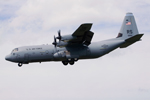
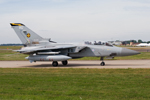
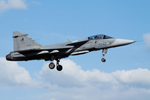
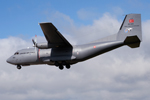
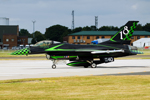
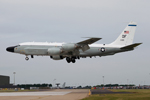
.jpg)
